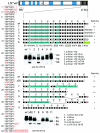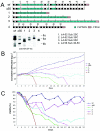Role of the mammalian RNA polymerase II C-terminal domain (CTD) nonconsensus repeats in CTD stability and cell proliferation
- PMID: 16107713
- PMCID: PMC1190292
- DOI: 10.1128/MCB.25.17.7665-7674.2005
Role of the mammalian RNA polymerase II C-terminal domain (CTD) nonconsensus repeats in CTD stability and cell proliferation
Abstract
The C-terminal domain (CTD) of mammalian RNA polymerase II (Pol II) consists of 52 repeats of the consensus heptapeptide YSPTSPS and links transcription to the processing of pre-mRNA. The length of the CTD and the number of repeats diverging from the consensus sequence have increased through evolution, but their functional importance remains unknown. Here, we show that the deletion of repeats 1 to 3 or 52 leads to cleavage and degradation of the CTD from Pol II in vivo. Including these repeats, however, allowed the construction of stable, synthetic CTDs. To our surprise, polymerases consisting of just consensus repeats could support normal growth and viability of cells. We conclude that all other nonconsensus CTD repeats are dispensable for the transcription and pre-mRNA processing of genes essential for proliferation.
Figures





References
-
- Ares, M., Jr., and N. J. Proudfoot. 2005. The Spanish connection: transcription and mRNA processing get even closer. Cell 120:163-166. - PubMed
-
- Baskaran, R., S. R. Escobar, and J. Y. Wang. 1999. Nuclear c-Abl is a COOH-terminal repeated domain (CTD)-tyrosine (CTD)-tyrosine kinase-specific for the mammalian RNA polymerase II: possible role in transcription elongation. Cell Growth Differ. 10:387-396. - PubMed
Publication types
MeSH terms
Substances
LinkOut - more resources
Full Text Sources
